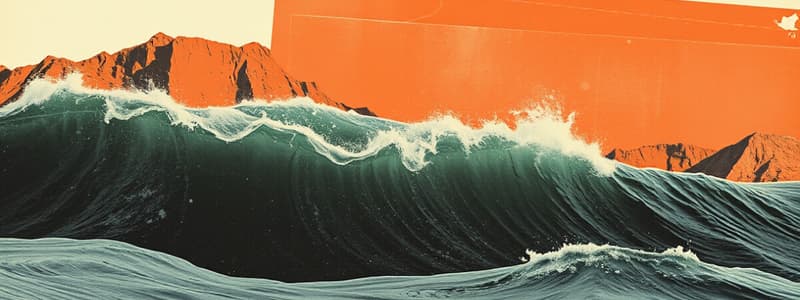Podcast
Questions and Answers
What is a longitudinal wave?
What is a longitudinal wave?
- A wave where matter moves back and forth along the direction of wave travel (correct)
- A wave that transfers energy without matter
- A wave where matter moves at right angles to the wave direction
- A wave that can travel through a vacuum
What are mechanical waves?
What are mechanical waves?
Waves that can travel only through matter.
What is a medium in wave terminology?
What is a medium in wave terminology?
The matter through which a wave travels.
Describe a transverse wave.
Describe a transverse wave.
What is an amplitude?
What is an amplitude?
What is a compression in a longitudinal wave?
What is a compression in a longitudinal wave?
What is a crest in a transverse wave?
What is a crest in a transverse wave?
Define frequency in wave terminology.
Define frequency in wave terminology.
What is the period of a wave?
What is the period of a wave?
What is rarefaction in a longitudinal wave?
What is rarefaction in a longitudinal wave?
Define trough in wave terminology.
Define trough in wave terminology.
What is a wavelength?
What is a wavelength?
What does diffraction refer to?
What does diffraction refer to?
Define interference in wave terms.
Define interference in wave terms.
What is a node in wave terminology?
What is a node in wave terminology?
What is refraction?
What is refraction?
Define resonance.
Define resonance.
What is a standing wave?
What is a standing wave?
Flashcards are hidden until you start studying
Study Notes
Wave Types
- Longitudinal Wave: Matter moves back and forth in the same direction as the wave travels.
- Transverse Wave: Matter moves perpendicularly to the wave direction, characterized by crests (high points) and troughs (low points).
- Mechanical Wave: Requires a medium (solid, liquid, gas) to travel through, cannot propagate in a vacuum.
Wave Properties
- Wave: Defined as a repeating disturbance that transfers energy through space or matter.
- Medium: The substance or material that carries the wave.
- Amplitude: Indicates the disturbance size of a wave, correlating with energy carried; higher amplitude means more energy.
Wave Measurements
- Frequency: The number of wavelengths that pass a fixed point each second, measured in hertz (Hz).
- Period: The time it takes for one wavelength to pass a point, expressed in seconds.
- Wavelength: The distance between two identical points on consecutive waves, affecting wave frequency and speed.
Wave Phenomena
- Compression: Areas of high density in a longitudinal wave, where particles are closely packed.
- Rarefaction: Areas of low density in a longitudinal wave, where particles are spread out.
- Diffraction: The bending of waves around obstacles or when passing through narrow openings.
- Refraction: The bending of waves when they change speed as they move into a different medium.
Wave Interactions
- Interference: Occurs when two or more waves overlap and combine, resulting in a new wave pattern.
- Node: Points in a standing wave where interfering waves cancel each other out, leading to no movement.
Special Wave Concepts
- Crest: The peak of a transverse wave.
- Trough: The lowest point of a transverse wave.
- Standing Wave: A stationary wave pattern formed by interference of two waves traveling in opposite directions with equal wavelength and amplitude.
- Resonance: The process by which an object vibrates at its natural frequency due to energy absorption.
Studying That Suits You
Use AI to generate personalized quizzes and flashcards to suit your learning preferences.




